
The drugstore beetle, also known as the bread beetle, biscuit beetle, and misnamed as the biscuit weevil, is a tiny, brown beetle. It can be found infesting a wide variety of dried plant products, where it is among the most common non-weevils to be found. It is the only living member of the genus Stegobium. It belongs to the family Ptinidae, which also includes the deathwatch beetle and furniture beetle. A notable characteristic of this species is the symbiotic relationship the beetles have with the yeast they carry, which are transmitted from female to larvae through the oviduct.

Cleridae are a family of beetles of the superfamily Cleroidea. They are commonly known as checkered beetles. The family Cleridae has a worldwide distribution, and a variety of habitats and feeding preferences.

Lasioderma serricorne, more commonly referred to as the cigarette beetle, cigar beetle, or tobacco beetle, is a small beetle that shares a remarkable resemblance with the drugstore beetle and the common furniture beetle. The cigarette beetle, along with the drugstore and furniture beetles, all belong to the Ptinidae beetle family. The cigarette beetle can be distinguished from A. punctatum by its flatter thorax, whereas the A. punctatum boasts a humped thorax. The cigarette beetle can be further differentiated from S. paniceum with its uniformly serrated antennae composed of 11 segments, unlike the three-segmented antennae of S. paniceum. Additionally, L. serricorne has more shallow grooves in its elytra, or hardened wing covers, compared to the A. punctatum and S. paniceum’s deep grooving.
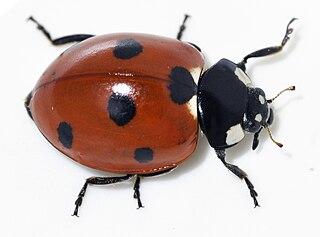
Coccinellidae is a widespread family of small beetles. They are commonly known as ladybugs in North America and ladybirds in the United Kingdom; "lady" refers to mother Mary. Entomologists use the names ladybird beetles or lady beetles to avoid confusion with true bugs. The more than 6,000 described species have a global distribution and are found in a variety of habitats. They are oval beetles with a domed back and flat underside. Many of the species have conspicuous aposematic (warning) colours and patterns, such as red with black spots, that warn potential predators that they taste bad.

Monochamus scutellatus, commonly known as the white-spotted sawyer or spruce sawyer or spruce bug or a hair-eater, is a common wood-boring beetle found throughout North America. It is a species native to North America.

Brumoides suturalis, the three-striped lady-beetle, is a species of ladybird described by Johan Christian Fabricius in 1789. It is found in India, Pakistan, Bangladesh, Sri Lanka, Bhutan, Nepal, Indonesia, Philippines and Papua New Guinea.
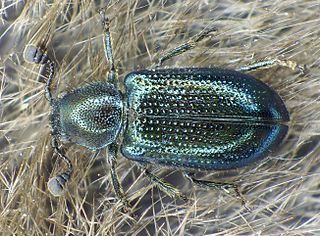
Necrobia violacea is a species of beetle in family Cleridae. Cleridae beetles are a predaceous beetle found within forest and woodland environments, and can be associated with stored food products as both pests and predators of other insects.

Laricobius nigrinus is a species of tooth-necked fungus beetle in the family Derodontidae. It is native to western North America, and it is being studied as a biological control agent for the hemlock woolly adelgid. It was first released in 2003 and continues to be reared and released across the Northeast to control infestations.
Boschella is a genus of checkered beetles in the family Cleridae. There is one described species in Boschella, B. fasciata.

Dinoderus is a genus of bamboo powderpost beetles in the family Bostrichidae. There are more than 20 described species in Dinoderus.
Paratillus is a genus of checkered beetles in the family Cleridae. There is one described species in Paratillus, P. carus.

Harmonia octomaculata is a species of ladybird of the family Coccinellidae. It is found throughout India, Pakistan, Nepal, Bangladesh, Sri Lanka, Micronesia, and Australia.
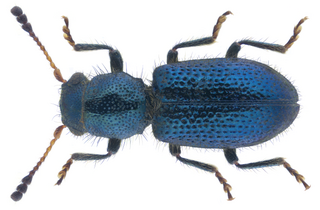
Korynetes is a genus of beetles belonging to the family Cleridae.

Illeis cincta, is a species of lady beetle native to India, Sri Lanka and Indonesia.
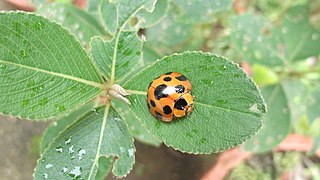
Synonycha grandis, commonly known as Giant bamboo ladybird, is a species of lady beetle found in Australia, Oceania and Southern Asia.
Pseudaspidimerus uttami is a species of lady beetle native to India and Sri Lanka.
Pseudaspidimerus mauliki, is a species of lady beetle native to India, Sri Lanka, Bangladesh, Thailand, and Java.
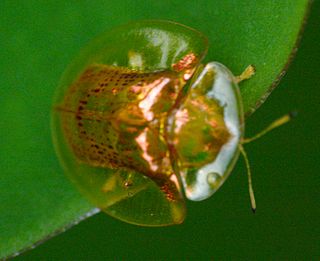
Aspidimorpha dorsata, commonly known as golden tortoise beetle or furcated tortoise beetle, is a species of leaf beetle widely distributed in Oriental region from Sri Lanka to South China towards Java, and Borneo.
Barbara Ingeborg Patricia Barratt is a New Zealand entomologist and biocontrol expert. In 2022, she was elected as fellow of the Royal Society Te Apārangi.

Tilloidea is a genus of checkered beetles in the family Cleridae. There are about six described species in Tilloidea. They are found in Europe, North Africa, South and Southeast Asia, and Pacific islands.














